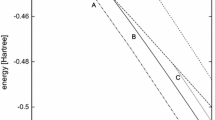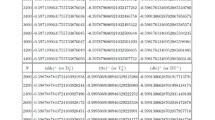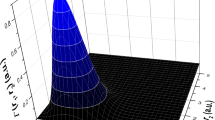Abstract
The energies of the low-lying bound S-states of some two-electron systems (treating them as three-body systems) like negatively charged hydrogen, neutral helium, positively charged-lithium, beryllium, carbon, oxygen, neon, argon and negatively charged muonium and exotic positronium ions have been calculated employing hyperspherical harmonics expansion method. The matrix elements of two-body interactions involve Raynal–Revai coefficients which are particularly essential for the numerical solution of three-body Schrődinger equation when the two-body potentials are other from Coulomb or harmonic. The technique has been applied for to two-electron ions 1H− (Z = 1) to 40Ar16+ (Z = 18), negatively charged-muonium Mu− and exotic positronium ion Ps−(e + e − e −) considering purely Coulomb interaction. The available computer facility restricted reliable calculations up to 28 partial waves (i.e. K m = 28) and energies for higher K m have been obtained by applying an extrapolation scheme suggested by Schneider.
Similar content being viewed by others
References
Ancarani, L.U., Rodriguez, K.V., Gasaneo, G.: Ground and excited states for exotic three-body atomic systems. In: EPJ Web of Conferences vol. 3, p. 02009 (2010); Correlated 1,3 S States for Coulomb Three-Body Systems. Int. J. Quantum Chem. (2011) (and references therein)
Renat A.: Sultanov and Dennis Guster: Integral-differential equations approach to atomic three-body systems. J. Comput. Phys. 192(1), 231 (2003)
Chen Z., Lin C.D.: Classification of Coulomb three-body systems in hyperspherical co-ordinates. Phys. Rev. A 42(1), 18 (1990)
Yalcin Z., Simsek M.: Potential harmonic approximation in atomic three-body systems with Fues–Kratzer-type potential. Int. J. Quantum Chem. 88(6), 735 (2002)
Kleindienst L., Emrich R.: The atomic three-body problem. An accurate lower bond calculation using wave functions with logarithmic terms. Int. J. Quantum Chem. 37(3), 257 (1990)
Baklanov E.V.: Ground state of negative positronium ion within the framework of the non-relativistic three-body problem. Laser Phys. 7(4), 970 (1997)
Dodd L.R.: Faddeev approach to atomic three-body problems. Phys. Rev. A 9(4), 637 (1974)
Harris Frank E.: Current studies of few-electron systems. Lecture Ser. Comput. comput. Sci. 1, 1 (2006)
Krivec R., Mandelzweig V.B.: Matrix elements of potentials in the correlation function hyperspherical harmonic method. Phys. Rev. A 42, 3779 (1990)
Haftel H.I., Mandelzweig V.B.: A fast convergent hyperspherical expansion for the helium ground state. Phys. Lett. A 120(5), 232 (1987)
Haftel H.I., Mandelzweig V.B.: Exact solution of coupled equations and the hyperspherical formalism: calculation of expectation values and wavefunctions of three Coulomb-bound particles. Ann. Phys. 150(1), 48 (1983)
Rodriguez K.V., Ancarani L.U., Gasaneo G., Mitnik D.M.: Ground state for two-electron and electron-muon three-body atomic systems. Int. J. Quantum Chem. 110(10), 1820 (2010)
Smith V.H. Jr., Frolov A.M.: On properties of the helium-muonic and helium-antiprotonic atoms. J. Phys. B 28(7), 1357 (1995)
Frolov A.M., Smith V.H. Jr.: Bound state properties and astrophysical applications of negatively charged hydrogen ions. J. Chem. Phys. 119, 3130 (2003)
Frolov A.M., Yeremin A.Y.J.: Ground bound states in two-electron systems with Z = 1. J. Phys. B 22, 1263 (1989)
Frolov A.M., Smith V.H. Jr.: Universal variational expansion for three-body systems. J. Phys. B 28, L449 (1995)
Frolov A.M.: Bound state properties of negatively charged hydrogen like ions. Phys. Rev. A 58, 4479 (1998)
Frolov A.M.: Properties and hyperfine structure of helium-muonic atoms. Phys. Rev. A 61, 022509 (2000)
Frolov A.M.: Calculations of the 1sμ2s e -electron-excited S(L = 0) states in helium-muonic atoms. Phys. Rev. A 65, 024701 (2002)
Frolov A.M.: Lowest order QED corrections for the H− and Mu− ions. Phys. Lett. A 345, 173 (2005)
Frolov A.M.: Bound state properties and hyperfine splitting in the S(L = 0)-states of the lithium-muonic systems. Phys. Lett. A 353, 60 (2006)
Frolov A.M., Smith V.H. Jr.: Exponential representation in the Coulomb three-body problem. J. Phys. B 37, 2917 (2004)
Thakkar A.J., Koga T.: Ground-state energies for the helium isoelectronic series. Phys. Rev. A 50, 854 (1994)
Goldman S.P.: Uncoupling Correlated Calculations in atomic physics: very high accuracy and ease. Phys. Rev. A 57, R677 (1998)
Korobov R.: Bethe logarithm for the helium atom. Phys. Rev. A 69, 054501 (2004)
Drake G.W.F.: In: (eds) Units and Constants. Springer Handbook of Atomic, Molecular, and Optical Physics, pp. 1. Springer, Berlin (2005)
Hylleraas E.A., Ore A.: Electron affinity of positronium. Phys. Rev. 71, 491 (1947)
Hill R.N.: Proof that the H− ion has only one bound state. Details and extension to finite nuclear mass. J. Math. Phys. 18, 2316 (1977)
Mohr P.J., Taylor B.N.: The fundamental physical constants—recommended values of the basic constants and conversion values, from the 1998 adjustment. Phys. Today 55(8), BG6 (2002)
Drake G.W.F., Cassar M.M., Nistor R.A.: Ground-state energies for helium, H−, and Ps−. Phys. Rev. A 65, 054501 (2002)
Frolov A.M.: Variational expansions for the three-body Coulomb problem. Zh. Eksp. Teor. Fiz 92, 1959 (1987)
Mills A.P. Jr.: Observation of the positronium negative ion. Phys. Rev. Lett. 46, 717 (1981)
Mills A.P. Jr.: Measurement of the decay rate of the positronium negative ion. Phys. Rev. Lett. 50, 671 (1983)
Ho Y.K.: Autoionization states of the positronium negative ion. Phys. Rev. A 19, 2347 (1979)
Ho Y.K.: Variational calculation of ground-state energy of positronium negative ions. Phys. Rev. A 48, 4780 (1993)
Wen-Fang X.I.E.: Feature of a confined positronium negative ion by a spherical parabolic potential. Commun. Theor. Phys. 47, 547 (2007)
Kubiček K., Bruhns H., Braun J., López-Urrutia J.R.C., Ullrich J.: Two-loop QED contributions tests with mid-Z He-like ions. J. Phys. Conf. Ser. 163(01), 01 (2007)
Kondrashev S., Mescheryakov N., Sharkov B., Shumshurov A., Khomenko S., Makarov K., Satov Y., Smakovskii Y.: Production of He-like light and medium mass ions in laser ion source. Rev. Sci. Instrum. 71, 1409 (2000)
Abdul Khan Md.A., Dutta S.K., Das T.K.: Computation of Raynal–Revai coefficients for the hyperspherical approach to a three-body system. FIZIKA B (Zagreb) 8(4), 469 (1999)
Khan Md.A.: Hyperspherical three-body calculation for exotic atoms. Few-Body Syst. 52, 53 (2012)
Lin, C.D.: Hyperspherical coordinate approach to atomic and Coulombic three-body systems. Phys. Rep. 257(1), 1 (1995)
Das T.K., Chattopadhyay R., Mukherjee P.K.: Hyperspherical harmonics approach to the ground and excited states of two electron atoms. Phys. Rev. A 50, 3521 (1994)
Chattopadhyay R., Das T.K., Mukherjee P.K.: Hyperspherical harmonics expansion of the ground state of the Ps− ion. Phys. Scr. 54, 601 (1996)
Chattopadhyay R., Das T.K.: Adiabatic approximation in atomic three body systems. Phys. Rev. A 56, 1281 (1997)
Das T.K., Coelho H.T., Fabre de la Ripelle M.: Contribution of three body force to the trinucleon problem by an essentially exact calculation. Phys. Rev. C 26, 2288 (1982)
Coelho H.T., Das T.K., Fabre de la Ripelle M.: Effect of two pion exchange three nucleon forces on trinucleon systems. Phys. Lett. 109, 255 (1982)
Das T.K., Coelho H.T.: Trinucleon Coulomb energy with inclusion of three body force. Phys. Rev. C (Rapid comm) 26, 754 (1982)
Das T.K., Coelho H.T.: Dependence of trinucleon observables on three body force. Phys. Rev. C 26, 697 (1982)
Coelho H.T., Das T.K., Robilotta M.: Two pion exchange three nucleon force and the 3H and 3He nuclei. Phys. Rev. C 28, 1812 (1983)
De T.B., Das T.K.: Calculation of geometrical structure coefficients for the trinucleon system with central and tensor interactions. Phys. Rev. C 36, 402 (1987)
Brito V.P., Coelho H.T., Das T.K.: Adiabatic approximation in few body molecular and nuclear systems. Phys. Rev. A 40, 3346 (1989)
Ghosh A.K., Das T.K.: Triton asymptotic normalization constants by the hyperspherical harmonics expansion method. Phys. Rev. C 42, 1249 (1990)
Das T.K., Coelho H.T., Torreao J.R.A.: Hyperspherical harmonics approach for the trinucleon system with hard core potential. Phys. Rev. C 45, 2640 (1992)
Bhattacharya S., Das T.K., Kanta K.P., Ghosh A.K.: Convergence of triton asymptotic wave function for hyperspherical harmonics expansion with two nucleon Reid soft core potential. Phys. Rev. C 50, 2228 (1994)
Yakhelef, A., Timofeyuk, N., Al-Khalili, J.S.,Thompson, I.J.: Three-body spectrum of 18 C and its relevance to r-process nucleosynthesis. Few-Body Syst. 47, 213 (2010)
Khan Md.A., Dutta S.K., Das T.K., Pal M.K.: Hyperspherical three-body calculation for neutron drip line nuclei. Phys. G Nucl. Part. Phys. 24, 1519 (1998)
Khan Md.A., Das T.K., Chakrabarti B.: Study of the excited state of double-Λ hypernuclei byhyperspherical supersymmetric approach. Int. J. Mod. Phys. E 10(2), 107 (2001)
Khan Md.A., Das T.K.: Study of ΛΛ dynamics and ground state structure of low and medium mass double Λ hypernuclei. Pramana J. Phys. 56(1), 57 (2001)
Khan Md.A., Das T.K.: Investigation of halo structure of 6He by hypersphericalthree-body method. Pramana J. Phys. 57(4), 701 (2001)
Dutta S.K., Khan Md.A., Das T.K., Chakrabarti B.: Calculation of resonances in weakly bound systems. Int. J. Mod. Phys. E 13(4), 811 (2004)
Dutta S.K., Das T.K., Khan Md.A., Chakrabarti B.: Resonances in A = 6 nuclei: Use of supersymmetric quantum mechanics. Few-Body Syst. 35, 33 (2004)
Dutta S.K., Das T.K., Khan Md.A., Chakrabarti B.: Computation of 2+ resonance in 6He: bound state in the continuum. J. Phys. G Nucl. Part. Phys. 29, 2411 (2003)
Khan M.A, Das T.K.: Investigation of exotic 6 ΛΛHe hypernuclei by the hyperspherical three-body method. FIZIKA B 9(2), 55 (2000)
Khan Md.A., Das T.K.: Investigation of ΛΛ dynamics and effective ΛN interaction in low and medium mass hypernuclei. FIZIKA B 10(2), 83 (2001)
Richard J.M.: The non-relativistic three-body problem for baryons. Phys. Rep. 212, 1 (1992)
Leeb H., Fiedeldey H., Gavin E.G.O., Sofianos S.A., Lipperheide R.: Quark quark potentials from the inversion of baryon spectra and its application to the Roper resonance. Few Body Syst. 12, 55 (1992)
Barnea N., Novoselsky A.: Construction of hyperspherical functions symmetrized with respect to the orthogonal and symmetric groups. Ann. Phys. (N. Y.) 256, 192 (1997)
Watanabe S., Hosoda Y., Kato D.: Hyperspherical close-coupling method extended to the two-electron continuum region: test on the s-wave model for e-H scattering. J. Phys. B 26, L495 (1993)
Raynal J., Revai J.: Transformation coefficients in the hyperspherical approach to the three-body problem. Il Nuo. Cim. A 68(4), 612 (1970)
Youping G., Fuqing L., Lim T.K.: Program to calculate Raynal–Revai coefficients of a three-body system in two or three dimensions. Comput. Phys. Commun. 47, 149 (1987)
Ballot J.L., Fabredela Ripelle M.: Application of the hyperspherical formalism to the trinucleon bound state problems. Ann. Phys. (N. Y.) 127, 62 (1980)
Cohen E.R., Taylor B.N.: CODATA recommended values of the fundamental physical constants. Phys. Today 51(8), BG9 (1998)
Cohen E.R., Taylor B.N.: CODATA recommended values of the fundamental physical constants. Phys. Today 53(8), BG11 (2000)
Beiner M., Fabredela Ripelle M.: Convergence of the hyperspherical formalism applied to the trinucleons. Lett. Nuvo Cim. 1(14), 584 (1971)
Schneider T.R.: Convergence of generalized spherical harmonic expansion in the three-nucleon bound state. Phys. Lett. 40(4), 439 (1972)
Johnson B.R.: The renormalized Numerov method applied to calculating bound states of the coupled-channel Schroedinger equation. J. Chem. Phys. 69, 4678 (1978)
Accad Y., Pekeris C.L., Schiff B.: Two-electron S and P term values with smooth Z dependence. Phys. Rev. A 11(4), 1479 (1975)
Author information
Authors and Affiliations
Corresponding author
Rights and permissions
About this article
Cite this article
Khan, M.A. Low-Lying S-States of Two-Electron Systems. Few-Body Syst 55, 1125–1139 (2014). https://doi.org/10.1007/s00601-014-0881-8
Received:
Accepted:
Published:
Issue Date:
DOI: https://doi.org/10.1007/s00601-014-0881-8




